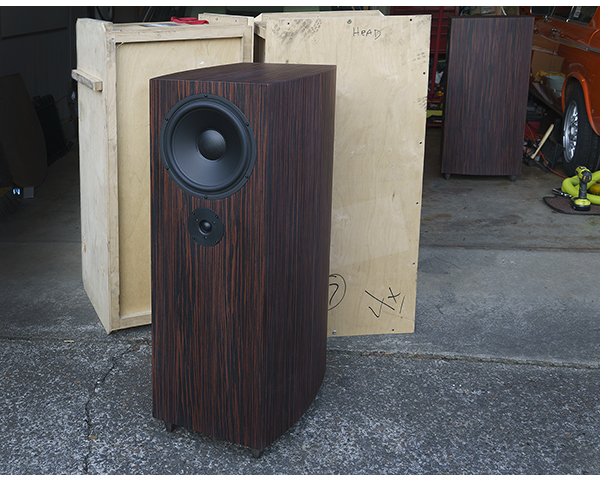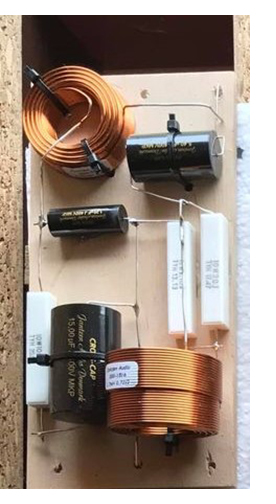The Audio GE Teddy Speakers
 There are some fun speakers in the $1,000 – $2,000 range, and there are a lot more mistakes.
There are some fun speakers in the $1,000 – $2,000 range, and there are a lot more mistakes.
But there are a few true classics, transcending time, offering sonic value that is out of what you think would be possible for this price. The Audio GE Teddy, at $1,888 a pair delivered, certainly has the potential to join the ranks of the finest.
If you have two thousand dollars burning a hole in your pocket to buy a new pair of speakers, you can be overwhelmed by the amount of choices on the market today. When arguing with our publisher about what we’d buy for that money, we always end up pontificating about the great speakers back in our day. We’re getting old. Old guys always like to think the stuff from their era is way better than the current stuff. We do the same thing with our endless arguments about cars – that’s why we both drive mid 70s BMW 2002s.
Yet today, there are better choices than ever. A few of our favorites remain – the Vandersteen 1, and the current entry level Magnepan speakers are still top contenders, nearly 40 years later. The KEF LS-50 is spectacular, along with some great choices from Totem, Paradigm and B&W. Sonus faber’s new Lumina line is brilliant too. It’s a great time to be getting in the game.
Audio GE is a relatively new company from Lithuania. I had a friend in college from Lithuania, he was a smart and witty guy, as I expect Gediminas Racevicus – the managing director and designer at Audio GE is. Anyone can make a great speaker for $200,000. You have to be clever to make an exceptional speaker for $2,000. I wanna meet this guy.
It’s also worth mentioning that for US customers, the Teddy’s are an even bigger deal – because of exchange rates, and the fact that Underwood HiFi has really sharpened the pencil on shipping to get these to you in the CONUS for just under $1,995 shipped, it’s more like getting a $3,000 pair of speakers at this price. They’ve pared it to a single finish option to get you the best deal. Great hifi just got easier.
A shitload of amplifiers
Comedian David Letterman when asked “how many is in a shitload,” replied, “Seven. There are seven in a shitload.” And that’s exactly how many amplifiers were used in evaluating the Teddys. As I had to pick them up from TONE HQ after the photos were taken, this made for a great listening session with a few of the amplifiers in use there. Of course, the Teddy’s sound great with the reference PASS Labs XA200.8 monoblocks, but at that price, these amplifiers are completely irrelevant in the context of a $2,000 pair of speakers. And that’s the oldest hifi store/show trick in the book. Play inexpensive speakers through six figures worth of amplification to reel you in, then when you get them home you get the ultimate metal gift – disappointment. We’ve all been there.
The McIntosh MC1502 is still a bit crazy for these speakers, but again – fantastic. However, at my place, a Mk V version of the classic MC275 provides an incredibly similar vibe, and considering a nice, used MC275 can be had for around $3k, this would make a lovely combination, and stay within a realistic budget. The tubed Mac provides more than enough power (90 watts per channel), and like the PrimaLuna EVO 400 (with EL34 tubes) delivers a slightly mellow, warm overall sound.
The Mac and PrimaLuna amps deliver a more diffuse presentation than some of the other amplifiers in the rotation, however they offer up some of the yummiest midrange and top to bottom cohesiveness. This is where audio can drive you to madness, but it’s good fun. (isn’t it?) It’s worth mentioning again that these are not power-hungry speakers.
How about a PS Audio Sprout II for $599, a Rega IO, or a vintage Marantz 2220B? (Freshly recapped and aligned by our pals at Gig Harbor Audio) The magic is still there. These speakers kick major butt with budget sources, and that’s what entry level music loving audiophiles need to get excited about.
What you get
Browsing the Audio GE website shows off the crossover network, made of premium parts (including capacitors from Jensen and Mundorf), revealing both drivers sourced from Scan-Speak. As someone who’s always enjoyed “that sound,” it makes more sense why I’m drawn to these.
 The cabinets are well built, and offered in a number of different finish options, so you should be able to find something that will go with your décor. (or if you cohabitate with someone, something that will go with their décor – ha!) Fortunately, they have a single set of binding posts – another nod to the beginning audiophile, not expecting them to bi-wire.
The cabinets are well built, and offered in a number of different finish options, so you should be able to find something that will go with your décor. (or if you cohabitate with someone, something that will go with their décor – ha!) Fortunately, they have a single set of binding posts – another nod to the beginning audiophile, not expecting them to bi-wire.
The only thing you don’t get is a pair of grilles, but hey who really uses them anyway?
Further setup and listening
A nice sized pair of floorstanding speakers with a bottom firing port, that makes for easy placement and setup. Speakers with rear firing ports are tough to get right for those of you that have to have your speakers a little closer to the walls, and front ports can “huff” a bit at low frequencies. There are a lot of five-figure speakers that take advantage of down-firing ports, so once again, Mr. Racevicus is a smart guy.
Personally, I think the downward firing port makes for a smoother transition as the woofer goes up the frequency range. Kind of like a 282 camshaft in a 2002, but again, I’m getting off track. Placed in my 14 x 19 foot listening room, about three feet from the rear walls, and about 8 feet apart proved optimum. As the soft dome tweeter is not edgy at all, feel free to experiment with toe-in. You can dial in more toe in with these speakers not being harsh. It all depends on your preference, as well as the overall voicing of your system.
Thanks to the wide dispersion characteristics of the soft dome tweeter and the general coherence of a two way system to begin with, the Teddy’s broad sweet spot makes for great times hanging out and listening to music. You’ll get a more precise image sitting right there, on the couch, but whether you’re sitting on the floor, or even in the next room, the sound is inviting.
GE Audio claims bass extension to 33hz, so I dug out my Stereophile test disc to investigate. The Teddy’s have seriously solid bass response to 30hz, so this meant a couple of long listening sessions of heavy rock music, just to feel it. Whether I was playing Dark Side of The Moon, Made in Japan, or anything inbetween, these speakers really offer a solid foundation underneath any of your music.
The lack of grunge from the crossover network, combined with that soft dome tweeter, makes for comfortable long listening sessions. This is a speaker you’ll be able to easily listen to all day without tiring of. Many speakers in this price range have an accentuated treble response (by design) to feel “detailed,” but they usually aren’t speakers you can listen to, especially with budget electronics.
Regardless of the program material used, the Teddy’s are luscious. Yes, slightly on the warm side, but not murky. Tracking through a long play list of jazz cuts, and the required female vocals reveals some major magic. Though they wouldn’t play terribly loud, shaking the dust from my Bottlehead 2A3 monoblocks was incredibly involving, with a magic only those amps bring to the table.
Ongoing arguments
Both our publisher and I had no disagreement in awarding the GE Teddy speakers one of our Exceptional Value Awards for 2021. This is a pair of speakers that allow a tremendous amount of musical engagement at a price everyone can afford. Thanks to being so amplifier friendly, you can build a wide range of systems around them as well.
A new favorite and future classic. – Jerold O’Brien




